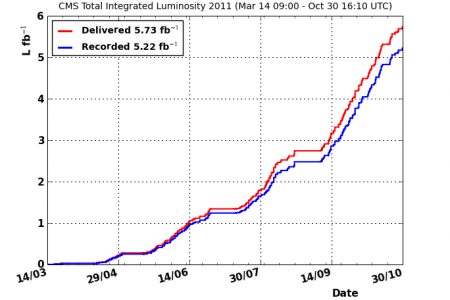
At about half-past five in the evening on Sunday, 30th October, an e-mail from Run Coordination to the CMS collaboration said:
At 17:00 today the LHC dumped the last proton beams for the year to start the machine development period and to prepare for the ion running. This means that we have come to the end of the proton operation for 2011.
And what a fantastic year of proton collisions it was! The LHC delivered around 5.73 fb−1 (inverse femtobarns) of data to CMS — of which CMS recorded about 5.22 fb−1 — surpassing by far expectations from before the start of the run.
“At the beginning of the year, they [the LHC] had first said they could deliver 1 fb−1, and then they learned a few things early so they revised it to 3,” said Joe Incandela, spokesperson-elect and current deputy spokesperson for CMS. “But it was clear by summer that we’d reach 5 or 6.”
“If I go back to the LHC Performance Workshop in Chamonix in January, I was asking them to give me five,” said CMS spokersperson Guido Tonelli, gesturing a high-five. “I was pushing to get 5 fb−1 because it will allow us to enter the region in which we might say something really important about the Higgs boson.”
The vast quantity of data accumulated by CMS in 2011 did not come without its challenges. “It took a lot of effort, for example, for the Trigger to balance CPU utilisation and the rate of recording data,” pointed out CMS Run Coordinator Anders Ryd. “Although CMS had a general infrastructure problem with the cooling in August, overall the proton run was pretty good.”
Incandela added: “The fact that we’ve recorded nearly 91% under tough conditions is phenomenal.”
These data will help CMS refine not just the Higgs searches but also those involving, for example, Supersymmetry and Exotica (new physics beyond the Standard Model). “Having recorded so much data will eventually allow us, if there are fluctuations, to have a better understanding of what is happening. If there are the first hints of new physics signals, they could manifest themselves,” said Tonelli.
It isn’t sufficient just to collect collision data — these data must be rapidly processed and analysed, in time for international conferences, where the results will be scrutinised by other physicists. While the usual timeline to process a few inverse femtobarns is many months, CMS has produced well-understood results for the EPS-HEP and Lepton Photon conferences within weeks.
“The speed at which we have been able to deploy in producing results on the Higgs boson and the quality of these results is striking,” said Tonelli.
CMS has also produced excellent results relating to Supersymmetry, although no signs of it have been observed so far in any of the channels explored. According to Incandela, “This non-appearance of signals is already having a huge impact on understanding SUSY and dark matter.”
None of this, of course, would have been possible without the incredible performance of the LHC, which provided stable beams for 1364 hours in 2011.
Recounting the time he was asked if he was disappointed with the LHC for not having manifested Supersymmetry thus far, Incandela noted, “Of course I’m not disappointed! The LHC is doing what it’s supposed to do. This is why we have experiments — the theories could be wrong.”
Ryd had some well-deserved praise for the efforts involved in running the CMS detector: “We have been able to follow the luminosity evolution of the machine without any major problems. I’m happy that we are able to operate CMS at high efficiency with a crew of basically five people in the Control Room with a lot of support from on-call people.”
Some records from the 2011 proton run:
Peak instantaneous luminosity: 3.55 x 1033 Hz/cm2 in fill 2256 (26th October)
Delivered luminosity in one fill: 123 pb−1 in fill 2219 (16th October)
Maximum luminosity in one day: 136 pb−1 (13th October)
Maximum luminosity delivered in one week: 538 pb−1 in week 41
Maximum luminosity delivered in one month: 1614 pb−1 in October
— Submitted by Achintya Rao
- Log in to post comments

